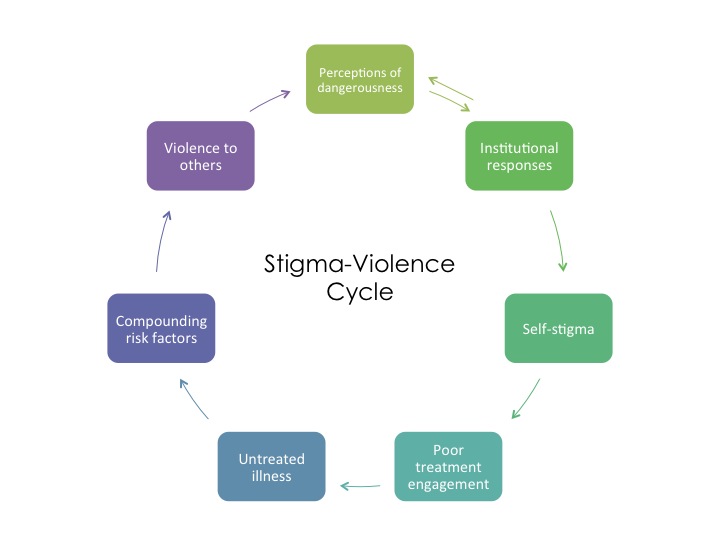Stigma against mentally ill persons is a major problem and has increased in incidence. Multiple studies have suggested that the perception of violent behavior by seriously mentally ill individuals is an important cause of stigma. It is also known that treating seriously mentally ill people decreases violent behavior. Therefore, the most effective way to decrease stigma is to make sure that patients receive adequate treatment.
Stigma can lead to discrimination.
Discrimination may be obvious and direct, such as someone making a negative remark about your mental illness or your treatment. Or it may be unintentional or subtle, such as someone avoiding you because the person assumes you could be unstable, violent or dangerous due to your mental illness. You may even judge yourself.
In today’s media reports about mental illness, there is a tendency to emphasize a supposed link between violence and mental illness. News stories regularly suggest that there is a strong connection between mental illness and crime. But the majority of people who are violent do not suffer from mental illnesses. In fact, people with a mental illness are more likely to be the victims, rather than the perpetrators of violence.
People, including children and adolescents, with untreated mental health disorders are at high risk for many unhealthy and unsafe behaviors, including alcohol or drug abuse, violent or self-destructive behavior, and suicide — the 11th leading cause of death in the United States for all age groups and challenges popular notions about the mentally ill as violent and dangerous, finding that people with mental illnesses are 2.5 times more likely than others to be murdered.
Understanding Mental Illness
Mental illnesses can take many forms, just as physical illnesses do. Mental illnesses are still feared and misunderstood by many people, but the fear will disappear as people learn more about them. If you, or someone you know, has a mental illness, there is good news: all mental illnesses can be treated.
At Mental Health Works, you can learn about more about mental illnesses – which can also be called psychiatric disorders – and their treatment. You will also find helpful resources that provide more information to further your understanding of mental illness.
Facts About Mental Illness and Violence
Here is what researchers say about the link between mental illness and violence:
Fact 1: The vast majority of people with mental illness are not violent.
– “Although studies suggest a link between mental illnesses and violence, the contribution of people with mental illnesses to overall rates of violence is small, and further, the magnitude of the relationship is greatly exaggerated in the minds of the general population (Institute of Medicine, 2006).”
– “…the vast majority of people who are violent do not suffer from mental illnesses (American Psychiatric Association, 1994).”
– “The absolute risk of violence among the mentally ill as a group is very small. . . only a small proportion of the violence in our society can be attributed to persons who are mentally ill (Mulvey, 1994).”
-“People with psychiatric disabilities are far more likely to be victims than perpetrators of violent crime (Appleby, et al., 2001). People with severe mental illnesses, schizophrenia, bipolar disorder or psychosis, are 2 ½ times more likely to be attacked, raped or mugged than the general population (Hiday, et al.,1999).”
Fact 2: The public is misinformed about the link between mental illness and violence.
A longitudinal study of American’s attitudes on mental health between 1950 and 1996 found, “the proportion of Americans who describe mental illness in terms consistent with violent or dangerous behavior nearly doubled.” Also, the vast majority of Americans believe that persons with mental illnesses pose a threat for violence towards others and themselves (Pescosolido, et al., 1996, Pescosolido et al., 1999).
Fact 3: Inaccurate beliefs about mental illness and violence lead to widespread stigma and discrimination.
The discrimination and stigma associated with mental illnesses stem in part, from the link between mental illness and violence in the minds of the general public (DHHS, 1999, Corrigan, et al., 2002).
Fact 4: The link between mental illness and violence is promoted by the entertainment and news media.
“Characters in prime time television portrayed as having a mental illness are depicted as the most dangerous of all demographic groups: 60 percent were shown to be involved in crime or violence” (Mental Health American, 1999).
“Most news accounts portray people with mental illness as dangerous” (Wahl, 1995).
“The vast majority of news stories on mental illness either focus on other negative characteristics related to people with the disorder (e.g., unpredictability and unsociability) or on medical treatments. Notably absent are positive stories that highlight recovery of many persons with even the most serious of mental illnesses” (Wahl, et al., 2002).
The Effects of Stigma and Discrimination are Profound.
The President’s New Freedom Commission on Mental Health found that, “Stigma leads others to avoid living, socializing, or working with, renting to, or employing people with mental disorders – especially severe disorders, such as schizophrenia.
It leads to low self-esteem, isolation, and hopelessness.
It deters the public from seeking and wanting to pay for care. Responding to stigma, people with mental health problems internalize public attitudes and become so embarrassed or ashamed that they often conceal symptoms and fail to seek treatment (New Freedom Commission, 2003).”
Facts About Recovery
Fact 1: Many studies show that most people with mental illnesses get better, and many recover completely. With support, between 70 and 90 percent of individuals have a significant reduction of symptoms, an improved quality of life, and find a satisfying measure of achievement and independence.
Fact 2: Today psychosocial and pharmacological treatments for individuals even with serious mental illness are highly effective.
Fact 3: Effective treatment for people with mental illness varies depending on the individual.
Fact 4: Positive response to treatment for mental illness is higher than for many physical illnesses.
How does the Stigma and Violence Affect Women?
More than 1 in 5 women in the United States experienced a mental health condition in the past year, such as depression or anxiety.
Many mental health conditions, such as depression and bipolar disorder, affect more women than men or affect women in different ways from men. It also found that women are more likely to internalize emotions, which typically results in withdrawal, loneliness, and depression, while men are more likely to externalize emotions, leading to aggressive, impulsive, coercive, and noncompliant behavior.
False beliefs and a lack of education about mental illness can cause significant problems. These beliefs contribute to the fear that ‘stigma’ of mental health issues lead women into suffering in silence while hiding their conditions.
The study showed that women who reported domestic violence had significantly higher rates of depression, somatization, anxiety, phobias, dissociation, alcohol abuse and drug dependence than women who reported no adult domestic violence.
Why do More Male Partners Become Abusive?
Abuse is driven by the desire for control — to maintain power in the relationship and assume a position of superiority. Violence also involves troubling cultural norms, particularly in cases of men sexually assaulting women. Whether the brain perceives the partner as part of the self or not may also play a role, research suggests.
Abusers often isolate their victims from family, friends, work, and any other outside sources of support. They may have explosive tempers and become violent during an abusive episode; afterward, they become remorseful and try to woo their partner back with charm and affection and promises to change, but the abusive behavior rarely stops.
Domestic abuse perpetrated by men against women is rooted in women’s unequal status in society and is part of the wider social problem of male violence against women and girls. We found in our research with the University of Bristol that sexism and misogyny set the scene for male abusive partners’ coercive and controlling behaviors, with a study showing 77% of abuse cases perpetrated by men against women
Sexism and misogyny serve to excuse abusive behavior by men in intimate relationships with women and put up barriers to female survivors being believed and supported to leave abusive men (Women’s Aid et al, 2021). Read the blog about this research here.
Educate Education Educated is required!
How does Domestic Violence affect Someone Psychologically?
Domestic violence can be physical or psychological, and it can affect anyone of any age, gender, race, or sexual orientation.
Victims of domestic violence experience diminished self-worth, anxiety, depression, and a general sense of helplessness that can take time and often professional help to overcome.
A Sibling’s Guide to Psychosis: Information, Ideas and Resources
As part of a national project to raise awareness about first-episode psychosis and support the needs of families affected by the illness, the Canadian Mental Health Association has developed this ASiblingsGuideToPsychosis – a guide intended to provide information and support to teens and young adults who have a brother or sister experiencing psychosis.
Citations
American Psychiatric Association. (1994). Fact Sheet: Violence and Mental Illness. Washington, DC: American Psychiatric Association.
Appleby, L., Mortensen, P. B., Dunn, G., & Hiroeh, U. (2001). Death by homicide, suicide, and other unnatural causes in people with mental illness: a population-based study. The Lancet, 358, 2110-2112.
Corrigan, P.W., Rowan, D., Green, A., et al. (2002) .Challenging two mental illness stigmas: Personal responsibility and dangerousness. Schizophrenia Bulletin, 28, 293-309.
DHHS. Mental Health: A Report of the Surgeon General. Rockville, MD: U.S. Department of Health and Human Services, Substance Abuse and Mental health Services Administration, Center for Mental Health Services, National Institutes of Health, National Institute of Mental Health, 1999. http://www.surgeongeneral.gov/library/mentalhealth/toc.html
Hiday, V. A. (2006). Putting Community Risk in Perspective: a Look at Correlations, Causes and Controls. International Journal of Law and Psychiatry, 29, 316-331.
Institute of Medicine, Improving the Quality of Health Care for Mental and Substance-Use Conditions. Washington, DC: Institute of Medicine, 2006.Mental Health America. American Opinions on Mental Health Issues. Alexandria: NMHA, 1999.
Mulvey, E. P. (1994). Assessing the evidence of a link between mental illness and violence. Hospital and Community Psychiatry, 45, 663-668.
Pescosolido, B.A., Martin, J.K., Link, B.G., et al. Americans’ Views of Mental Health and Illness at Century’s End: Continuity and Change. Public Report on the MacArthur Mental health Module, 1996General Social Survey. Bloomington: Indiana Consortium for Mental Health Services Research and
Joseph P. Mailman School of Public Health, Columbia University, 2000. Available: http://www.
indiana.edu/~icmhsr/amerview1.pdfPescosolido, B.A., Monahan, J. Link, B.G. Stueve, A., & Kikuzawa, S. (1999). The public’s view of the competence, dangerousness, and need for legal coercion of persons with mental health problems. American Journal of Public Health, 89, 1339-1345.
New Freedom Commission on Mental Health, Achieving the Promise: Transforming Mental Health Care in America. Final Report. DHHS Pub. No. SMA-03-3832. Rockville, MD: 2003.
Wahl, O. (1995). Media Madness: Public Images of Mental Illness. New Brunswick, NJ: Rutgers University Press.
Wahl, O.F., et al. (2002). Newspaper coverage of mental illness: is it changing? Psychiatric Rehabilitation Skills, 6, 9-31.
Stigma & Violence in Mental Health – Should We Disconnect the Dots?
August 1, 2023 by

